MRKT20052 Marketing Management: Ingogo Company Situation Analysis
VerifiedAdded on 2023/06/14
|11
|1059
|113
Presentation
AI Summary
This presentation provides a comprehensive situation analysis of Ingogo, an Australian online taxi booking and payment service. It covers the company's background, industry definition, macro force analysis using the PEST framework, customer analysis, competitor analysis focusing on Uber, and other stakeholder considerations. A SWOT analysis identifies Ingogo's strengths, weaknesses, opportunities, and threats. The presentation concludes that Ingogo has been a dominant player in the Australian market, offering a convenient mobile app and website for taxi bookings. The analysis also highlights the importance of adapting to potential competition and leveraging opportunities for future growth. Desklib offers a wide array of study resources including similar solved assignments and past papers to aid students in their academic pursuits.
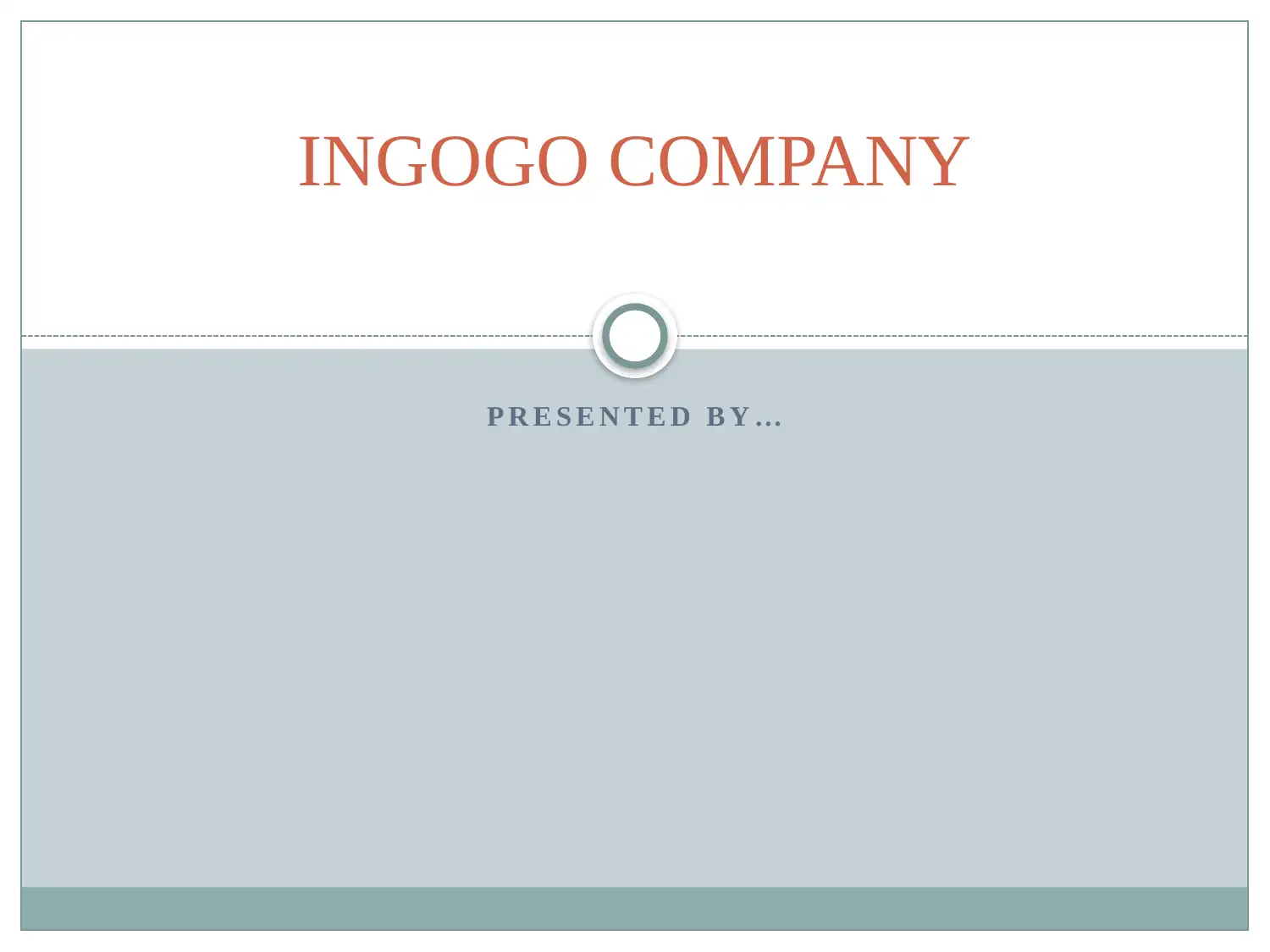
P R E S E N T E D B Y …
INGOGO COMPANY
INGOGO COMPANY
Paraphrase This Document
Need a fresh take? Get an instant paraphrase of this document with our AI Paraphraser
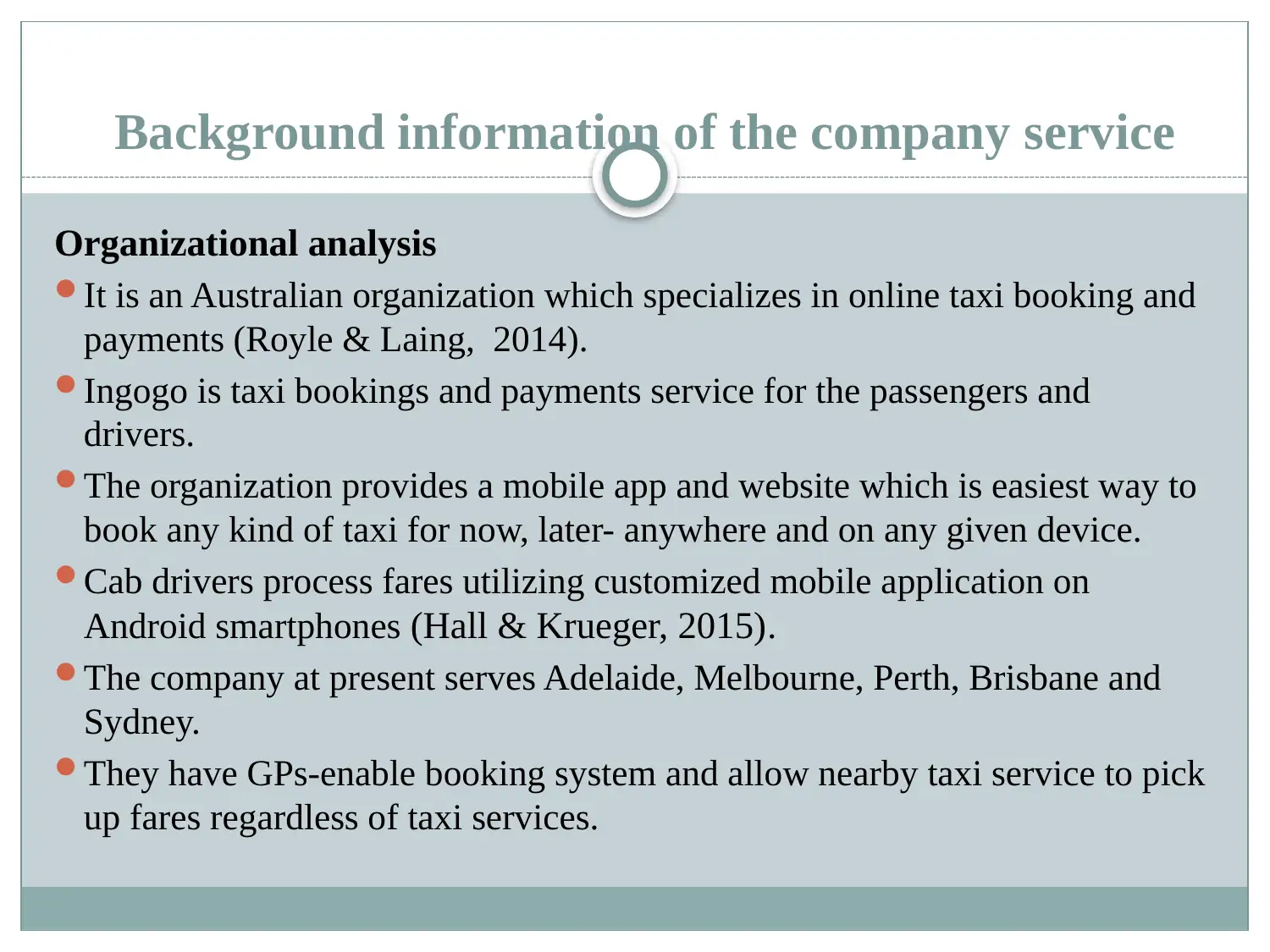
Background information of the company service
Organizational analysis
It is an Australian organization which specializes in online taxi booking and
payments (Royle & Laing, 2014).
Ingogo is taxi bookings and payments service for the passengers and
drivers.
The organization provides a mobile app and website which is easiest way to
book any kind of taxi for now, later- anywhere and on any given device.
Cab drivers process fares utilizing customized mobile application on
Android smartphones (Hall & Krueger, 2015).
The company at present serves Adelaide, Melbourne, Perth, Brisbane and
Sydney.
They have GPs-enable booking system and allow nearby taxi service to pick
up fares regardless of taxi services.
Organizational analysis
It is an Australian organization which specializes in online taxi booking and
payments (Royle & Laing, 2014).
Ingogo is taxi bookings and payments service for the passengers and
drivers.
The organization provides a mobile app and website which is easiest way to
book any kind of taxi for now, later- anywhere and on any given device.
Cab drivers process fares utilizing customized mobile application on
Android smartphones (Hall & Krueger, 2015).
The company at present serves Adelaide, Melbourne, Perth, Brisbane and
Sydney.
They have GPs-enable booking system and allow nearby taxi service to pick
up fares regardless of taxi services.
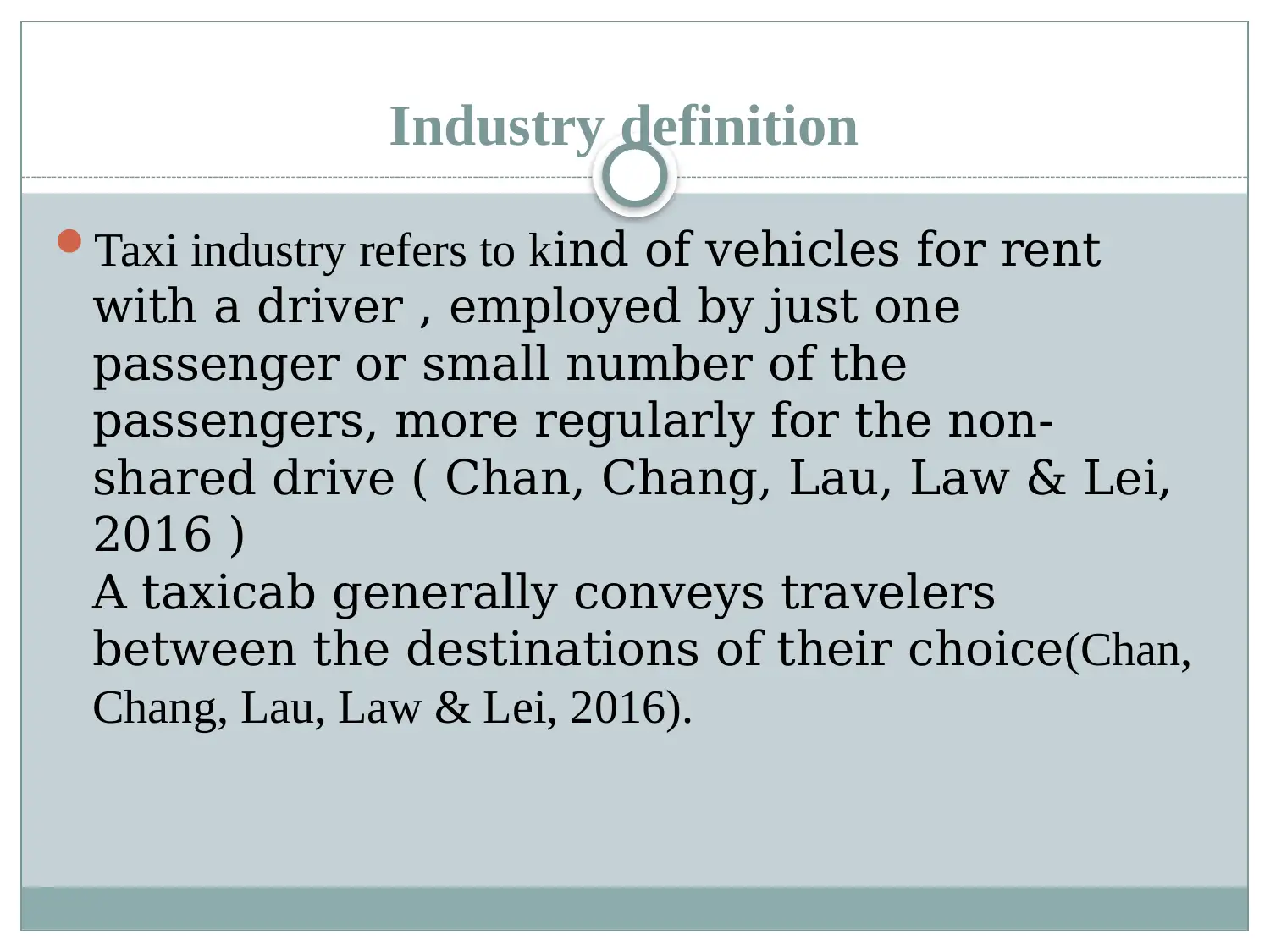
Industry definition
Taxi industry refers to kind of vehicles for rent
with a driver , employed by just one
passenger or small number of the
passengers, more regularly for the non-
shared drive ( Chan, Chang, Lau, Law & Lei,
2016 )
A taxicab generally conveys travelers
between the destinations of their choice(Chan,
Chang, Lau, Law & Lei, 2016).
Taxi industry refers to kind of vehicles for rent
with a driver , employed by just one
passenger or small number of the
passengers, more regularly for the non-
shared drive ( Chan, Chang, Lau, Law & Lei,
2016 )
A taxicab generally conveys travelers
between the destinations of their choice(Chan,
Chang, Lau, Law & Lei, 2016).
⊘ This is a preview!⊘
Do you want full access?
Subscribe today to unlock all pages.

Trusted by 1+ million students worldwide
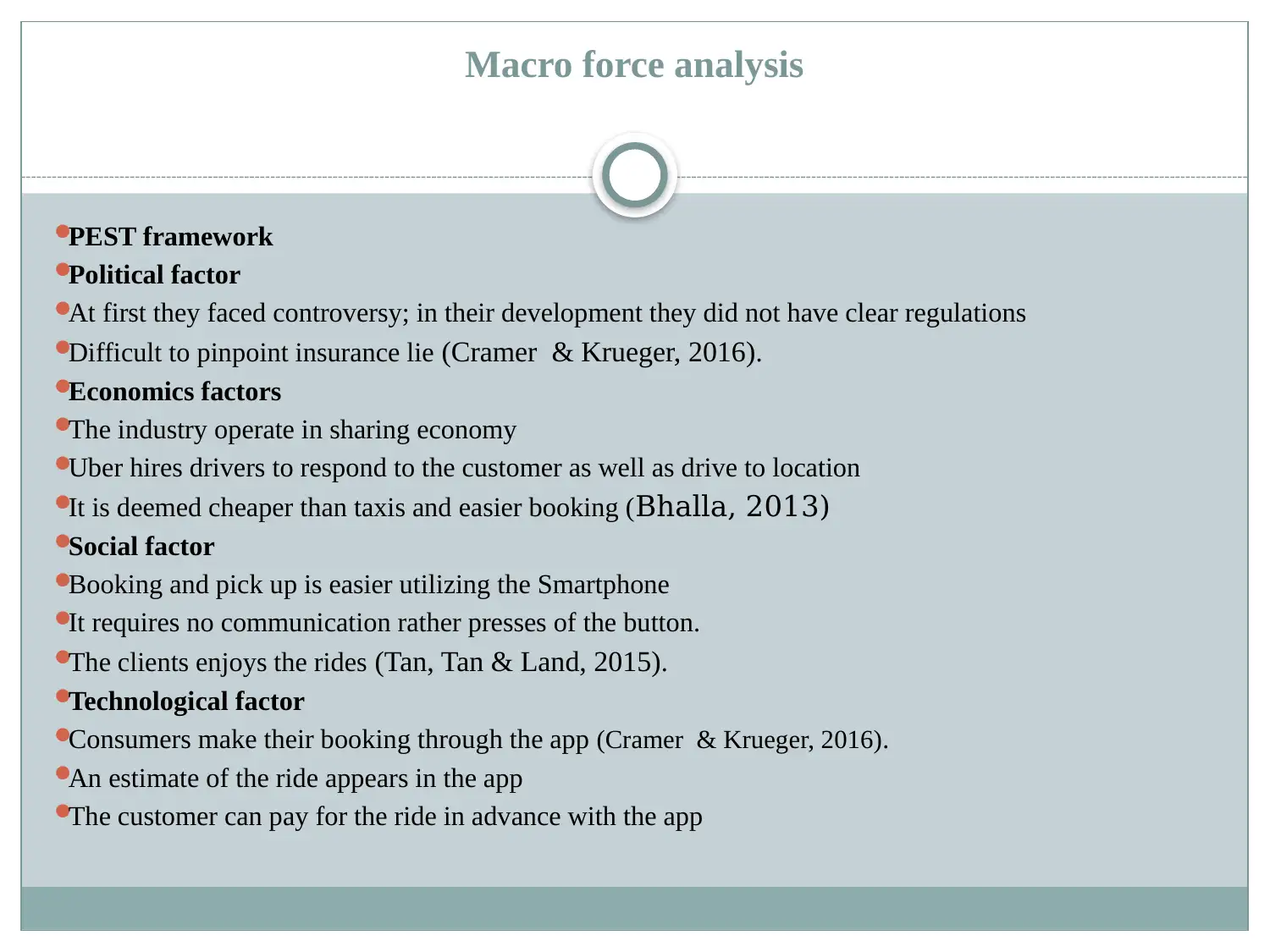
Macro force analysis
PEST framework
Political factor
At first they faced controversy; in their development they did not have clear regulations
Difficult to pinpoint insurance lie (Cramer & Krueger, 2016).
Economics factors
The industry operate in sharing economy
Uber hires drivers to respond to the customer as well as drive to location
It is deemed cheaper than taxis and easier booking (Bhalla, 2013)
Social factor
Booking and pick up is easier utilizing the Smartphone
It requires no communication rather presses of the button.
The clients enjoys the rides (Tan, Tan & Land, 2015).
Technological factor
Consumers make their booking through the app (Cramer & Krueger, 2016).
An estimate of the ride appears in the app
The customer can pay for the ride in advance with the app
PEST framework
Political factor
At first they faced controversy; in their development they did not have clear regulations
Difficult to pinpoint insurance lie (Cramer & Krueger, 2016).
Economics factors
The industry operate in sharing economy
Uber hires drivers to respond to the customer as well as drive to location
It is deemed cheaper than taxis and easier booking (Bhalla, 2013)
Social factor
Booking and pick up is easier utilizing the Smartphone
It requires no communication rather presses of the button.
The clients enjoys the rides (Tan, Tan & Land, 2015).
Technological factor
Consumers make their booking through the app (Cramer & Krueger, 2016).
An estimate of the ride appears in the app
The customer can pay for the ride in advance with the app
Paraphrase This Document
Need a fresh take? Get an instant paraphrase of this document with our AI Paraphraser
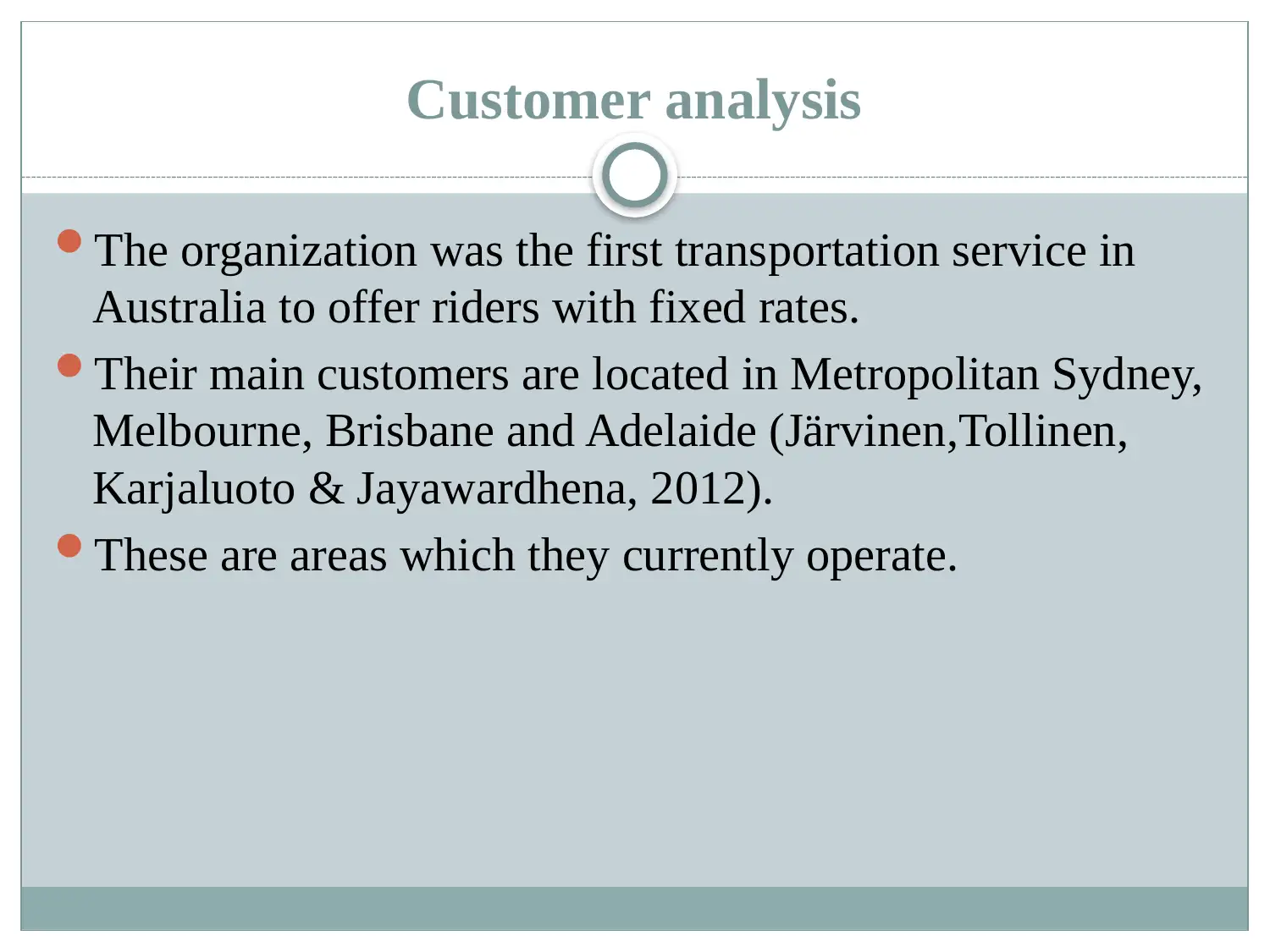
Customer analysis
The organization was the first transportation service in
Australia to offer riders with fixed rates.
Their main customers are located in Metropolitan Sydney,
Melbourne, Brisbane and Adelaide (Järvinen,Tollinen,
Karjaluoto & Jayawardhena, 2012).
These are areas which they currently operate.
The organization was the first transportation service in
Australia to offer riders with fixed rates.
Their main customers are located in Metropolitan Sydney,
Melbourne, Brisbane and Adelaide (Järvinen,Tollinen,
Karjaluoto & Jayawardhena, 2012).
These are areas which they currently operate.
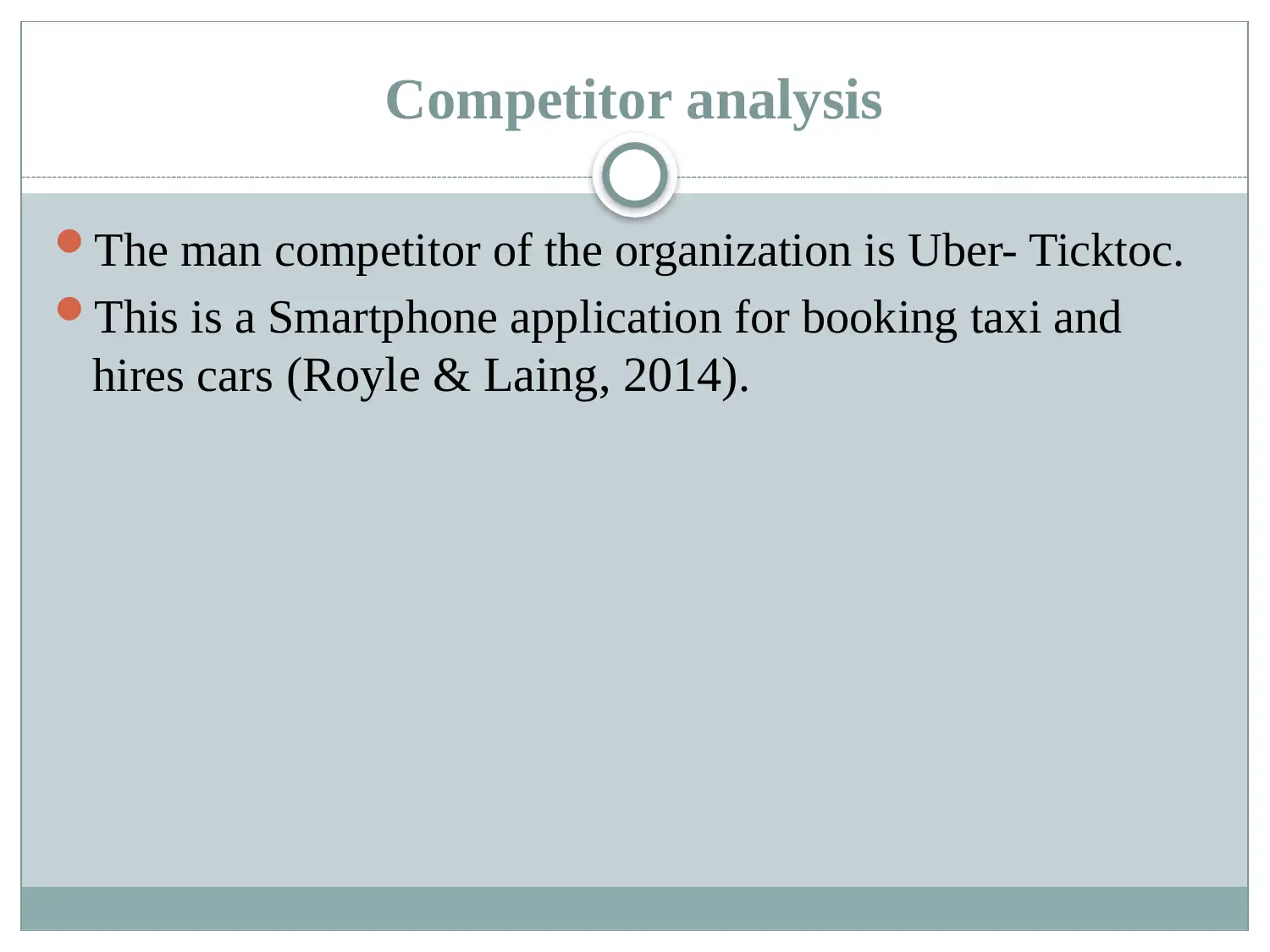
Competitor analysis
The man competitor of the organization is Uber- Ticktoc.
This is a Smartphone application for booking taxi and
hires cars (Royle & Laing, 2014).
The man competitor of the organization is Uber- Ticktoc.
This is a Smartphone application for booking taxi and
hires cars (Royle & Laing, 2014).
⊘ This is a preview!⊘
Do you want full access?
Subscribe today to unlock all pages.

Trusted by 1+ million students worldwide
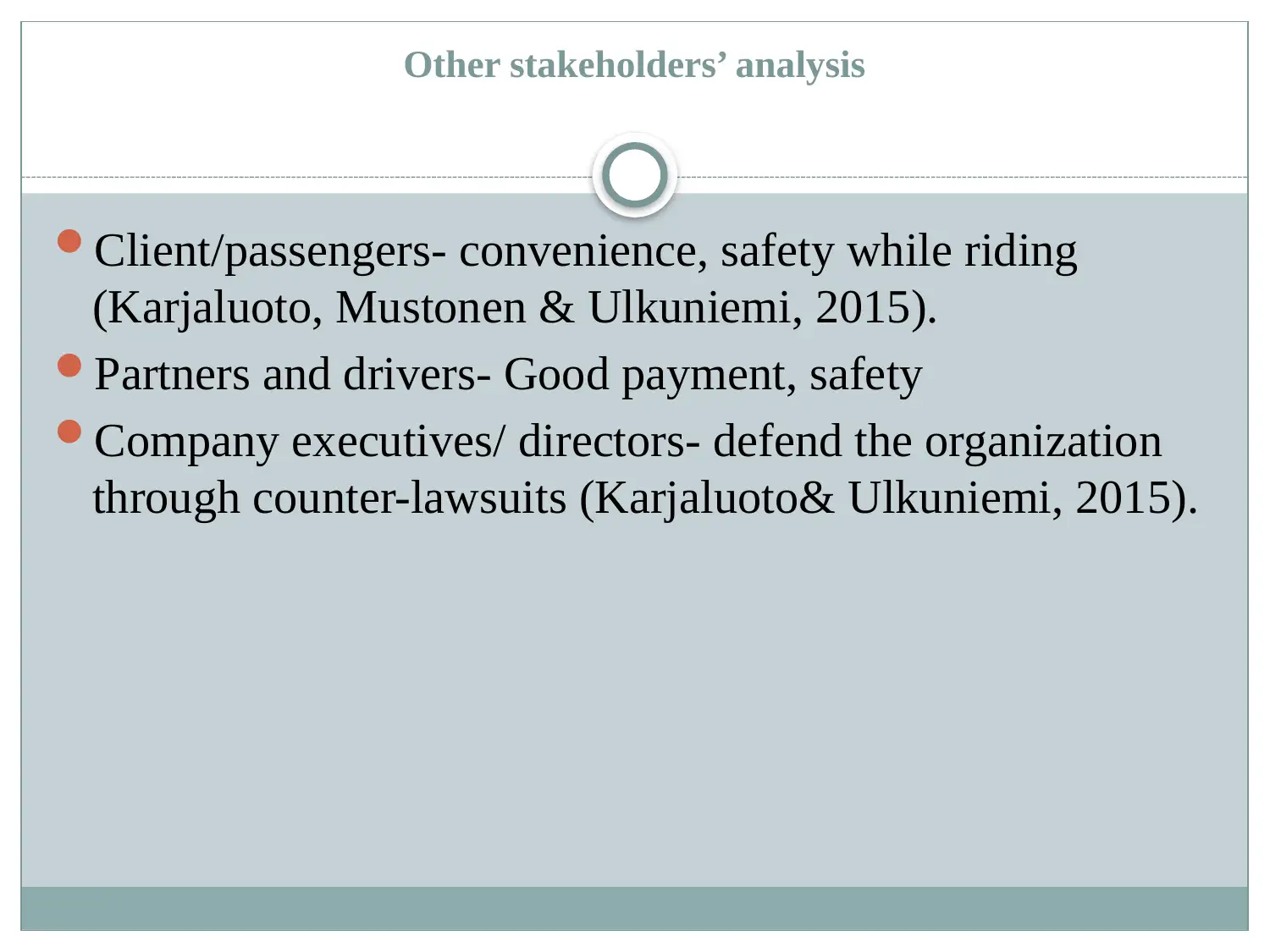
Other stakeholders’ analysis
Client/passengers- convenience, safety while riding
(Karjaluoto, Mustonen & Ulkuniemi, 2015).
Partners and drivers- Good payment, safety
Company executives/ directors- defend the organization
through counter-lawsuits (Karjaluoto& Ulkuniemi, 2015).
Client/passengers- convenience, safety while riding
(Karjaluoto, Mustonen & Ulkuniemi, 2015).
Partners and drivers- Good payment, safety
Company executives/ directors- defend the organization
through counter-lawsuits (Karjaluoto& Ulkuniemi, 2015).
Paraphrase This Document
Need a fresh take? Get an instant paraphrase of this document with our AI Paraphraser
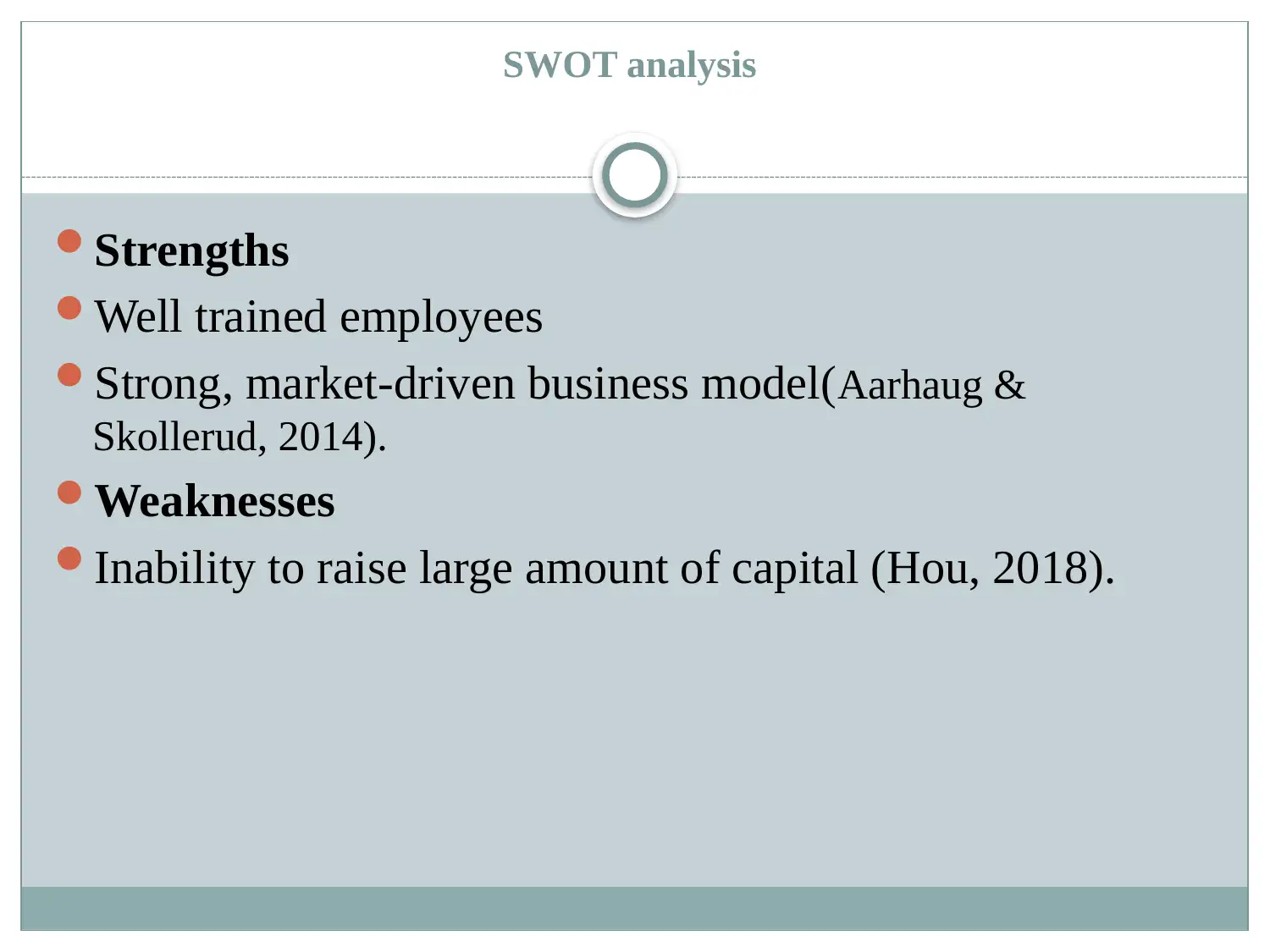
SWOT analysis
Strengths
Well trained employees
Strong, market-driven business model(Aarhaug &
Skollerud, 2014).
Weaknesses
Inability to raise large amount of capital (Hou, 2018).
Strengths
Well trained employees
Strong, market-driven business model(Aarhaug &
Skollerud, 2014).
Weaknesses
Inability to raise large amount of capital (Hou, 2018).
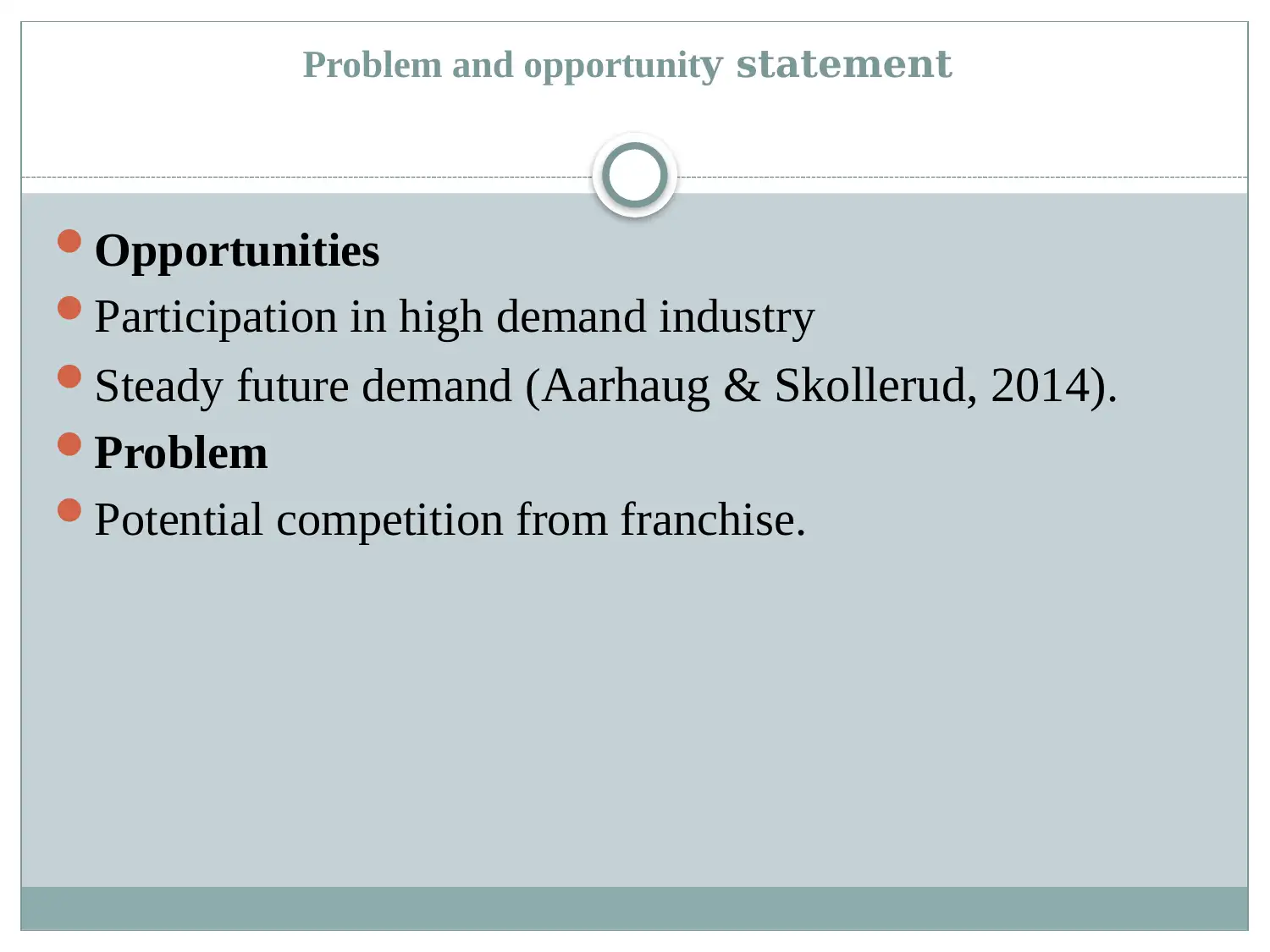
Problem and opportunity statement
Opportunities
Participation in high demand industry
Steady future demand (Aarhaug & Skollerud, 2014).
Problem
Potential competition from franchise.
Opportunities
Participation in high demand industry
Steady future demand (Aarhaug & Skollerud, 2014).
Problem
Potential competition from franchise.
⊘ This is a preview!⊘
Do you want full access?
Subscribe today to unlock all pages.

Trusted by 1+ million students worldwide
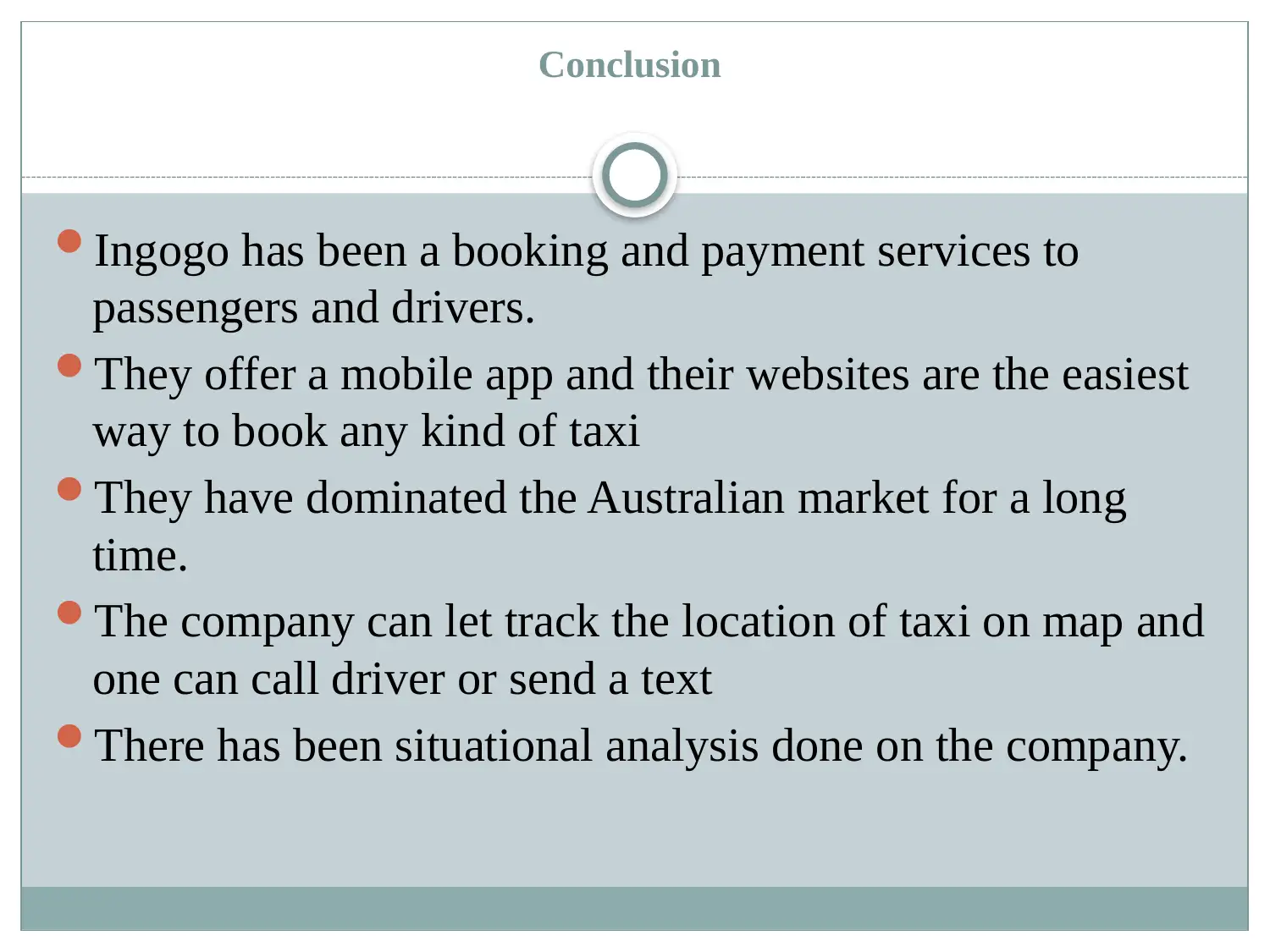
Conclusion
Ingogo has been a booking and payment services to
passengers and drivers.
They offer a mobile app and their websites are the easiest
way to book any kind of taxi
They have dominated the Australian market for a long
time.
The company can let track the location of taxi on map and
one can call driver or send a text
There has been situational analysis done on the company.
Ingogo has been a booking and payment services to
passengers and drivers.
They offer a mobile app and their websites are the easiest
way to book any kind of taxi
They have dominated the Australian market for a long
time.
The company can let track the location of taxi on map and
one can call driver or send a text
There has been situational analysis done on the company.
Paraphrase This Document
Need a fresh take? Get an instant paraphrase of this document with our AI Paraphraser
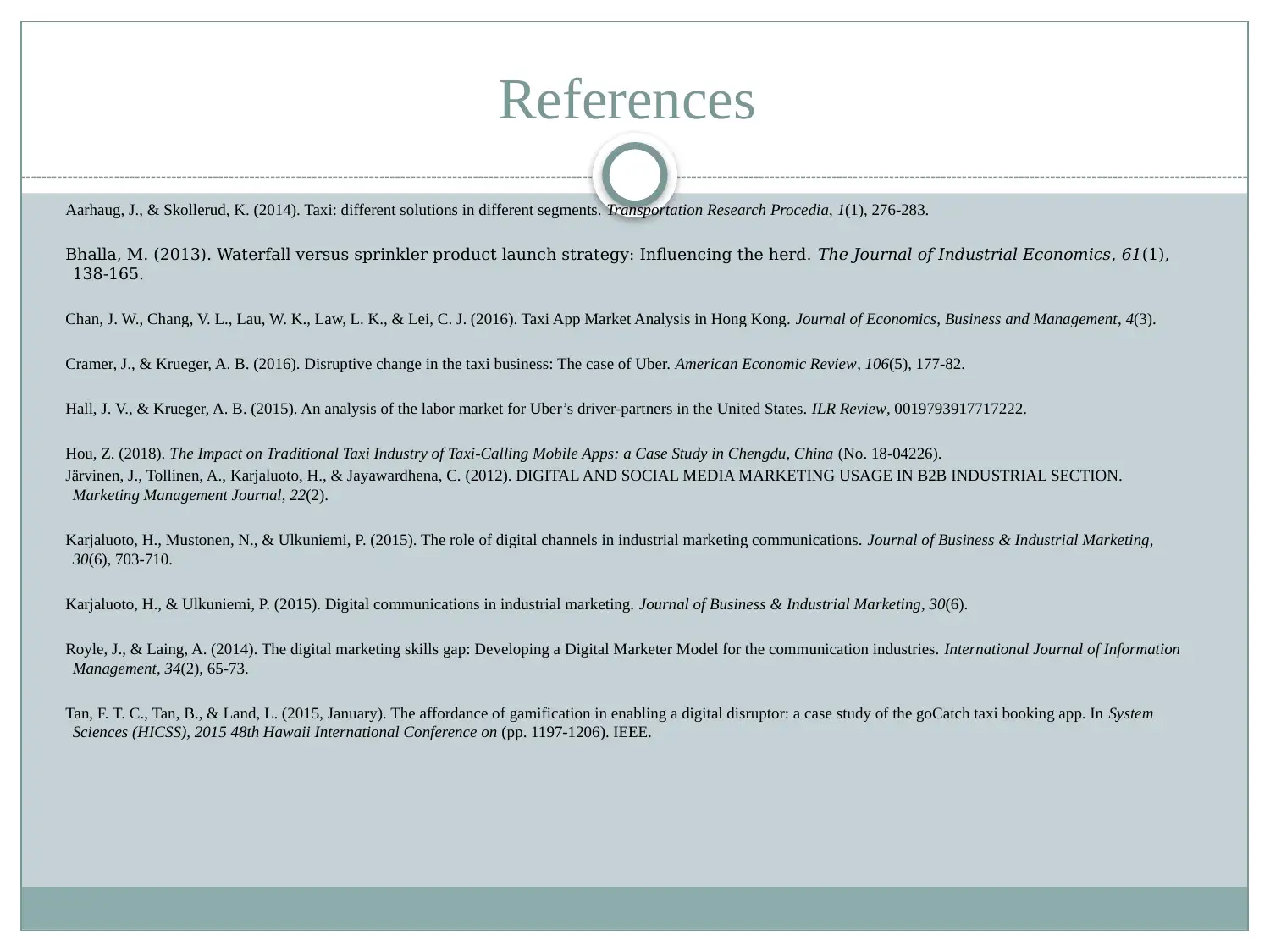
References
Aarhaug, J., & Skollerud, K. (2014). Taxi: different solutions in different segments. Transportation Research Procedia, 1(1), 276-283.
Bhalla, M. (2013). Waterfall versus sprinkler product launch strategy: Influencing the herd. The Journal of Industrial Economics, 61(1),
138-165.
Chan, J. W., Chang, V. L., Lau, W. K., Law, L. K., & Lei, C. J. (2016). Taxi App Market Analysis in Hong Kong. Journal of Economics, Business and Management, 4(3).
Cramer, J., & Krueger, A. B. (2016). Disruptive change in the taxi business: The case of Uber. American Economic Review, 106(5), 177-82.
Hall, J. V., & Krueger, A. B. (2015). An analysis of the labor market for Uber’s driver-partners in the United States. ILR Review, 0019793917717222.
Hou, Z. (2018). The Impact on Traditional Taxi Industry of Taxi-Calling Mobile Apps: a Case Study in Chengdu, China (No. 18-04226).
Järvinen, J., Tollinen, A., Karjaluoto, H., & Jayawardhena, C. (2012). DIGITAL AND SOCIAL MEDIA MARKETING USAGE IN B2B INDUSTRIAL SECTION.
Marketing Management Journal, 22(2).
Karjaluoto, H., Mustonen, N., & Ulkuniemi, P. (2015). The role of digital channels in industrial marketing communications. Journal of Business & Industrial Marketing,
30(6), 703-710.
Karjaluoto, H., & Ulkuniemi, P. (2015). Digital communications in industrial marketing. Journal of Business & Industrial Marketing, 30(6).
Royle, J., & Laing, A. (2014). The digital marketing skills gap: Developing a Digital Marketer Model for the communication industries. International Journal of Information
Management, 34(2), 65-73.
Tan, F. T. C., Tan, B., & Land, L. (2015, January). The affordance of gamification in enabling a digital disruptor: a case study of the goCatch taxi booking app. In System
Sciences (HICSS), 2015 48th Hawaii International Conference on (pp. 1197-1206). IEEE.
Aarhaug, J., & Skollerud, K. (2014). Taxi: different solutions in different segments. Transportation Research Procedia, 1(1), 276-283.
Bhalla, M. (2013). Waterfall versus sprinkler product launch strategy: Influencing the herd. The Journal of Industrial Economics, 61(1),
138-165.
Chan, J. W., Chang, V. L., Lau, W. K., Law, L. K., & Lei, C. J. (2016). Taxi App Market Analysis in Hong Kong. Journal of Economics, Business and Management, 4(3).
Cramer, J., & Krueger, A. B. (2016). Disruptive change in the taxi business: The case of Uber. American Economic Review, 106(5), 177-82.
Hall, J. V., & Krueger, A. B. (2015). An analysis of the labor market for Uber’s driver-partners in the United States. ILR Review, 0019793917717222.
Hou, Z. (2018). The Impact on Traditional Taxi Industry of Taxi-Calling Mobile Apps: a Case Study in Chengdu, China (No. 18-04226).
Järvinen, J., Tollinen, A., Karjaluoto, H., & Jayawardhena, C. (2012). DIGITAL AND SOCIAL MEDIA MARKETING USAGE IN B2B INDUSTRIAL SECTION.
Marketing Management Journal, 22(2).
Karjaluoto, H., Mustonen, N., & Ulkuniemi, P. (2015). The role of digital channels in industrial marketing communications. Journal of Business & Industrial Marketing,
30(6), 703-710.
Karjaluoto, H., & Ulkuniemi, P. (2015). Digital communications in industrial marketing. Journal of Business & Industrial Marketing, 30(6).
Royle, J., & Laing, A. (2014). The digital marketing skills gap: Developing a Digital Marketer Model for the communication industries. International Journal of Information
Management, 34(2), 65-73.
Tan, F. T. C., Tan, B., & Land, L. (2015, January). The affordance of gamification in enabling a digital disruptor: a case study of the goCatch taxi booking app. In System
Sciences (HICSS), 2015 48th Hawaii International Conference on (pp. 1197-1206). IEEE.
1 out of 11
Your All-in-One AI-Powered Toolkit for Academic Success.
+13062052269
info@desklib.com
Available 24*7 on WhatsApp / Email
![[object Object]](/_next/static/media/star-bottom.7253800d.svg)
Unlock your academic potential
Copyright © 2020–2025 A2Z Services. All Rights Reserved. Developed and managed by ZUCOL.

